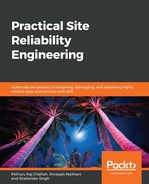Kubernetes is a portable and extensible open source platform for managing containerized workloads. Kubernetes automates the end-to-end container life cycle management activities. Configuration requirements are aptly declared, and a host of automation modules of the Kubernetes platform are working together in realizing the desired state. Having understood the strategic importance of Kubernetes, like cluster and orchestration platforms in effectively and efficiently running containers in cloud environments, we can see that tool ecosystem is growing fast. Containers, being the favorite runtime to host and execute microservices, are turning out to be the most tuned resource for the cloud era. For automating the container creation, running, dismantling, stopping, replacing, and replicating the contributions of container cluster and orchestration platform are growing well.
Kubernetes (k8s) eliminates many of the manual activities for deploying and scaling containerized applications. Multi-container composite applications, which are business-centric, process-aware, mission-critical, flexible, event-driven, cloud-hosted, and service-oriented, are the new way of producing enterprise-scale applications. Kubernetes plays a very vital role in producing such kinds of versatile, resilient, adaptive, adept, and dynamic applications. Kubernetes is making its way into every kind of cloud environment (private, public, hybrid, and edge).
As indicated previously, futuristic applications are being derived out of multiple containers being fused together, that is, containers have to be clustered and orchestrated to construct and deploy next-generation workloads in containerized cloud environments. Kubernetes orchestration enables building application services that span across multiple containers, schedules those containers across a cluster of nodes/hosts, scales those containers if necessary, and manages the health of those containers over time. The other important contributions of Kubernetes includes performing a seamless and spontaneous integration with networking, storage, telemetry, and other core services to give a comprehensive yet compact container infrastructures for workloads. The idea is to bring as much automation as possible to empower applications and services to deliver their functions as per the Service Level Agreements (SLAs) agreed between providers and users:

Having realized the strategic contributions of containers for the flourishing cloud era, the container embarkation journey started with clarity and confidence. The lightweight nature, along with high transparency, makes containers more conducive for cloud applications and infrastructures. The fallout is that the number of containers in a cloud center goes up significantly. Therefore, the operational and management complexities of containerized clouds are steadily increasing. The way forward is to bring in deeper and decisive automation through automated tools and platforms. For the sake of simplicity, Kubernetes enables multiple containers to be clubbed together as a pod. In a host/node/machine, there can be a few pods, and each pod comprises one or more containers. Docker networking capabilities can link multiple containers together. Kubernetes follows different mechanisms for container networking. Furthermore, Kubernetes schedules workloads onto container clusters. The load balancing feature of the Kubernetes platform can balance the dynamic loads across pods to ensure that the right number of containers are running all the time to facilitate the workloads so that they are delivered without any hitch and hurdle.
Containers are efficient in the sense that more work can be performed with less resources. The expensive IT resources are being maximally utilized to guarantee the required affordability. Software deployments and upgrades are being taken care of. Kubernetes mounts and adds storage to run stateful applications. It scales containers, and the containers instances to enhance the availability of containerized applications. All of the deployed software applications and their runtimes (containers) are being continuously monitored and managed. Various operational conditions, including the application health condition, are captured to do various appropriate activities, such as auto-scaling, replication, and so on. There are a number of open source tools emerging and evolving to make the leveraging of Kubernetes easy to use. There are several project initiatives and implementations for service and container image registries, networking, security, and so on. Kubernetes has become an automation, acceleration, and augmentation platform for containerized environments.
